Digging Dinosaurs in Hell Creek
Digging Dinosaurs in Hell Creek
Tales of the Therapod and a Terrific Triceratops
The adventure begins with a incredibly long car ride. Departing from Michigan, I drove to Montana. I wanted to bring my own tools and equipment. I did not want to risk losing my baggage in the airport or who knows where. My tool roll may have ended up in Mozambique instead of Montana.
We’ll skip ahead, many, many hours through Illinois, Iowa, South Dakota and finally into Montana. I have to say though, – every time I drive across this great United States, it still amazes me the wide open spaces, tall gleaming cities, wonderful people you meet and places you see when you just take the time to explore a bit.
I spent the final night of my cross country trip in a hotel in Spearfish, South Dakota. I highly recommend the Black Hills and that part of the Dakotas. An early riser, I jumped up, had breakfast and got underway again. Driving up toward Bell Foursce and across on highway 323, I saw literally hundreds of antelope along the side of the road in farm fields and prairie. It was, after all, early morning and they were out in force feeding. I crossed into Montana and encountered gridlock.
Let me explain. I turned off onto the highway toward EKALAKA, Montana and soon it turned into a gravel road. Signs posted everywhere marked this as open range ranching. That meant that cattle basically roamed free across the prairie.
Yup you guessed it. Cattle on, near, over and around the gravel roads.
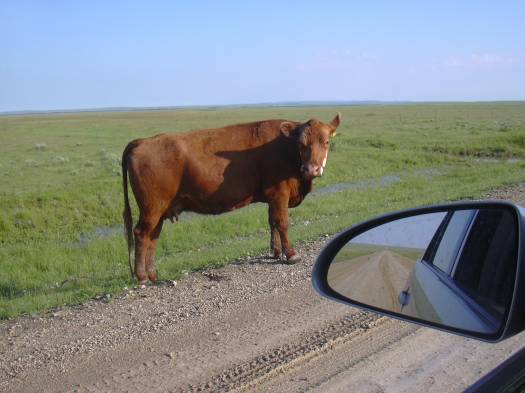
One of my many friends that caused gridlock
The cattle slowly would move out of the way and carry on with their simple lives. I however was anxious to reach camp NEEDMORE, my home for the next week.
Arriving in camp Needmore, I was pleasantly surprised to see one large cabin, and I correctly assumed that would be our meeting place, dining hall and community room. There were cabins scattered around the hillside nestled in tall Ponderosa Pines. I got there very early, the last digging crew had left that morning and the Burpee Museum crew was just stirring. The Burpee Museum of Natural History in Rockford, Illinois was the host for this foray into the badlands. They had prospected near Ekalaka for years turning up a juvenile Tyrannosaurus Rex dinosaur they named Jane, which is now on display at the Burpee, and a new site they called Homer. Homer was the remains of a Triceratops. Cool, I always wanted to work on a Triceratops.
The week prior to my, and the rest of the crews arrival, it had rained 6 out of the 7 days and digging was impossible. The ground of the badlands is full of Bentonite. When this stuff mixes with the mud and clay, the roads become impassable. To prove that point, the previous crew got a vehicle stuck in that slimy, muddy ooze. I prayed for a sunny week. Up to that point, according to the locals, it had been one of the wettest they can remember, but I’ll get back to that later.
The camp was in an area that reminded me of an Alpine forest. I walked to the top of a cliff that first morning to survey the area. What I saw nearly took my breath away. I was standing high on a chalk white ridge looking over a beautiful valley full of pines, bright green waving grass and a few homes dotted across the landscape. Beautiful.
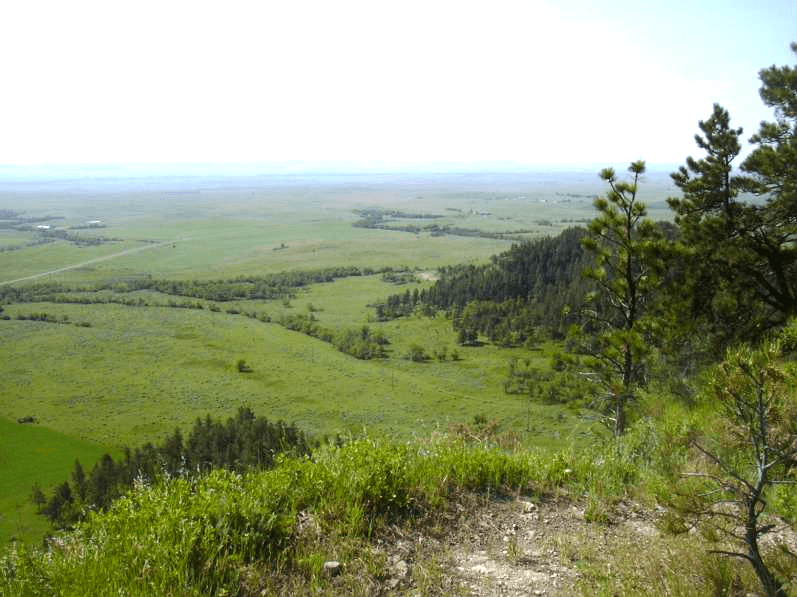
View from the top
After coming back down to camp, I met some of the diggers that had begun to arrive. Frank, a docent and guide from the American Museum of Natural History in New York City was to become my cabin mate as well as a retired engineer that lived in Illinois.
Many others joined the team as the day went by.
The cabins were really nice and we settled in. After dinner, I went up to my cabin, noted down a few thoughts and hit the sack early. I wanted an early start to the morning.
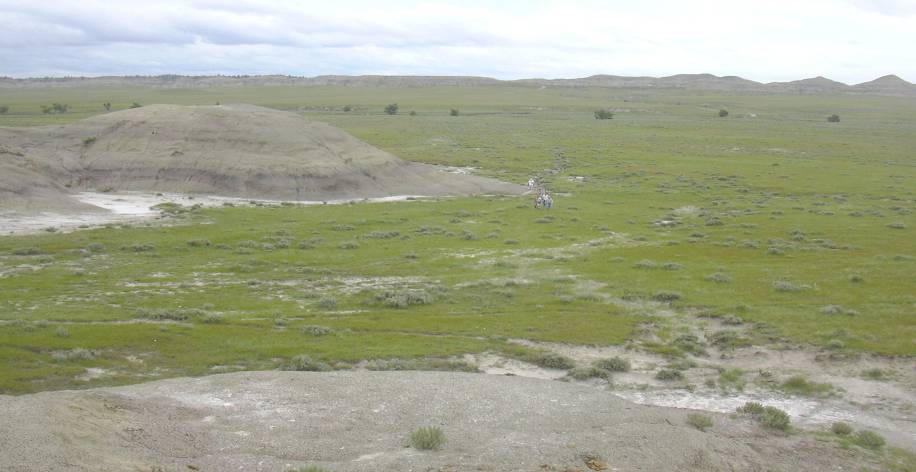
View back across the prairie from the digsite
DAY 1
I was pretty excited about digging a Triceratops. However fate had a different destiny planned for me – well at least the staff paleontologists from the Burpee. Since I had experience digging dinosaurs in the past, they had me work on a crew that was digging up a theropod. It was a meat eater. They had previously found a large leg bone of this quite large meat eater. The site was barely cleared so we began digging about 50 feet off the prairie floor where the bone had been discovered.
Let’s first talk float. Paleontologists spend a great deal of time walking around the badlands searching or prospecting for possible dinosaur sites. They walk around the cliffs searching for “float”. Float is bone material that “floats” down hill as it breaks off the main skeleton or bone. When float is found, they follow it up the hill until they find the source. Hopefully it is the tip of a dinosaur starting to weather out of the hill and not the last bone of the skeleton.
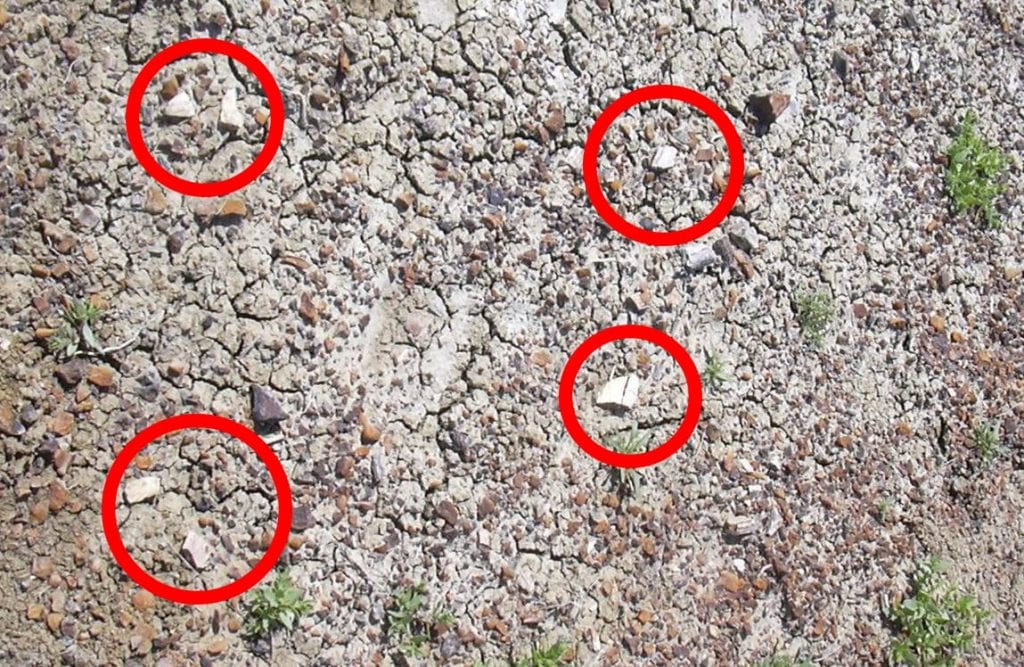
“Float” Bone weathering down hill (highlighted in the red circles
On a previous expedition the crews had found the float, followed it up hill and discovered a leg bone of the theropod. Our job was to search the hillside for more bones and the possibility of a complete meat eating dinosaur skeleton.
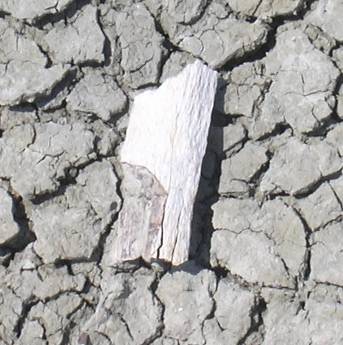
Close up of “Float” bone
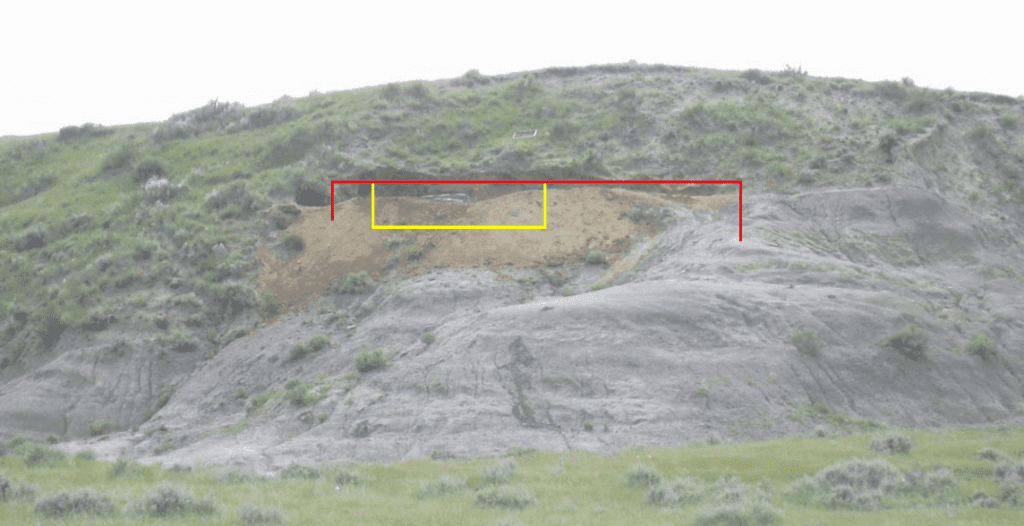
Dinosaur dig site Day 1 highlighted by yellow line, day 2 by the red line, busy little beavers, ah prairie dogs weren’t we ?
I spent two days there on that very same site digging and digging. I was lucky. I heard a little “tink”. Ah ha, bone. We were digging in sandy sediment. The environment there 67 to 65 million years ago was much like that of modern day Louisiana. Lowlands that were wet, with the constant threat of inundating floods. Perfect environment to preserve fossils, but that is another story. So in this area, if you hear a “tink” in the sand as you dig, it is nearly always a bone.
Back to my “tink” When I started sweeping away the sand, a bone came into view. It was part of the Humerus of the theropod. It was pretty badly deteriorated. There were roots growing through it, so it was deemed necessary to plaster jacket the area and move on. Great, I thought, one bone and that’s it. Well…… not really. A short distance away another “tink”, it was a piece of the vertebral column. That was in much better shape. It came out nicely in one piece. So much for day one, seems like very little got done, but that is the way of paleontology. We must move slowly in order not to damage and destroy the very things we are looking for. Actually it was a very good day. The dig site expanded outward (see photo above) and we were ready for day two. By the way, diggers on either side of me did also find bones. Toe bones and vertebra were found to either side of my dig site.
DAY 2
The day started out much as all digs start. We had breakfast, thanks to the great cooks on staff there. We packed our own lunches and plenty of water, piled into the vehicles for another long drive to the site. It took about 1 hour to drive through the prairie along rutted field roads to get to the site. Along the way we talked, looked out the window and dreamed of the ancient fossils we would uncover today.
Got to the location and got back down on the ground – not very glamorous, but we started digging. Then another “tink”, it was a piece of gastrailia. That is a bone that rarely fossilizes because it is so small and it deteriorates long before fossilization can take place, bonus!!!!
I left it in place believing that we would need to jacket it as well, when I began digging under it and of course, another “tink”. It was the proximal end of a rib. It was a big rib, alas – no Bar-B-Q sauce, but after slowly following the rib along in the dirt, it was about 3 feet long. It curved gently and it was in exceptional shape.
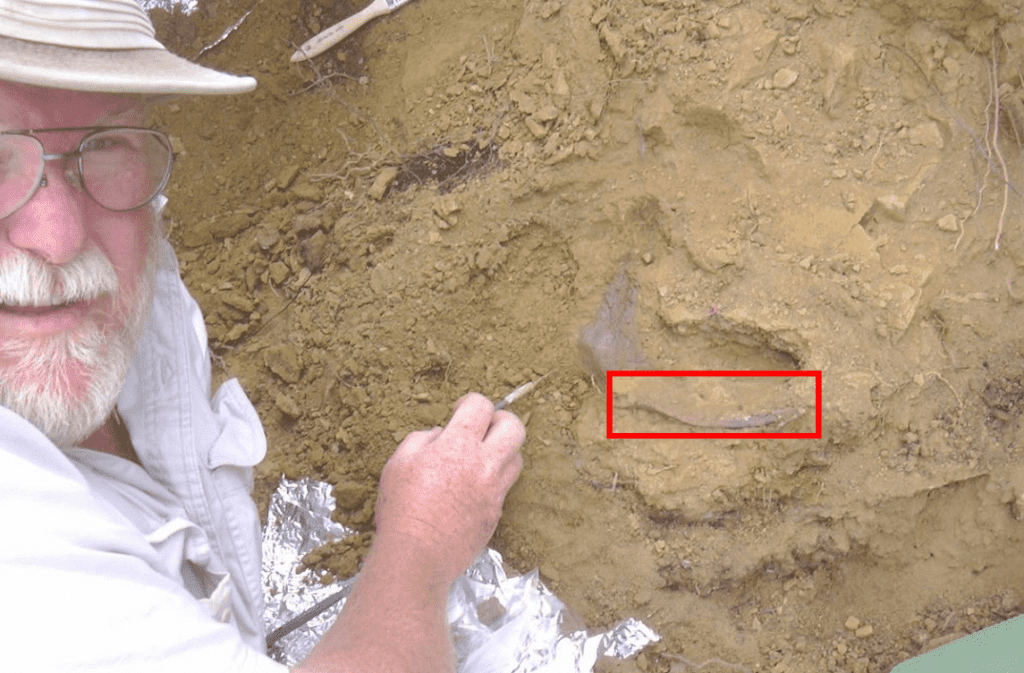
PaleoJoe pointing to the proximal end of the rib bone. The gastrailia lies just above it in the dirt, highlighted in red.
What a great start. I spent nearly the entire day digging that rib – taking breaks from the tediousness of gently brushing the rib – moving over to help out removing more over burden. Over burden is the dirt, rocks, grass, roots and stuff that lay atop the actual bed or horizon that you are digging. In our case we were removing about 3-4 feet of dirt so we could continue working into the hill. At the end of the day, we would cover the site with tarps and plastic to protect it from rain and possible damage. The day went well and I was getting pretty hot and tired. Evening was a welcome respite. We all ate dinner, an some turned in, like me, and others sat around playing cards, talking or whatever.
DAY 3
Surprise of surprises. We got to the site and saw a rabbit sitting near the site. It didn’t move. It stayed right there. The reason for the rabbits seeming fearlessness was that there was a little baby bunny sitting on our tarps. Slowly we pulled the first tarp away and the bunny – a really little one scampered away. As we removed the second tarp there was another little bunny under that one. Well we shooed it away and began our work.
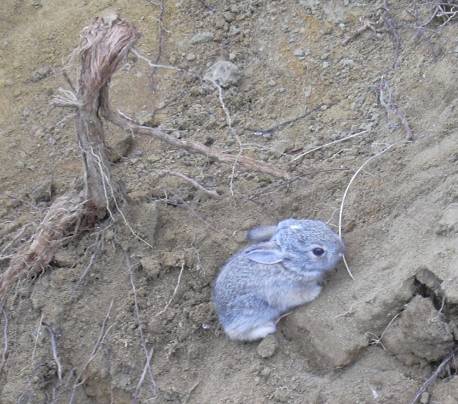
Baby Bunny 2 of our rabbit family.
We had a pretty good morning clearing out the dirt and continuing to dig. Several times we heard the roar of an afterburner and looked up just in time to see a B-1 bomber fly over the valley. They were so fast that by the time we heard them they were just leaving the valley. Once we did see them coming in low – as usual – and we all stood and waved. It must have been quite a sight for the pilot, a bunch of colorful dinosaur diggers in the middle of the badlands. We waved and waved fearing they wouldn’t see us, but the pilot did and rocked his plane back and forth waving back at us with the wingspan of his plane.
I worked for a while in the same area and was frankly, pretty sore from digging in the same position for two days. I thought I would go out on a “walkabout” prospecting for bones and just admiring the badlands. I walked along a short ridge above our dig site to a hilltop about a quarter of a mile away. At the top I stopped to enjoy the view. It had been one of the wettest springs and summers the locals could remember. The prairie was brilliant green. The flowers were in bloom, sagebrush growing tall and prairie grasses waving bright green in the plain below. The prickly pear cactus were blooming yellow, the barrel cactus were blooming a brilliant purple. The sky was deep blue with white billowing clouds far off in the distance. Several times during that week we could see far-off thunderstorms dropping heavy rain across the distant prairie, no trees, we could see for miles and miles. We could also see across the valley to where the other crew was excavating the Triceratops site – oh bother. I had wanted to work on a Triceratops too, but I guess the theropod was just as good. Well – therapod, meat eater – oh well, better.
Anyway I looked down at the ground – what’s this? Is it bone? I bent over and picked up two pieces of heavy solid masses of bone. I dug with my fingers and found more and more. I grabbed up the bone material and returned to the dig site. One of the members of the Burpee Museum was there and he said I had found two pieces of a Triceratops skull, a piece of a rib and I did recognize a vertebra. Not knowing much about the Triceratops I was surprised that that is what I had found.
The only problem was that the bones were pretty badly damaged due to weathering. So with all the other work the teams were doing, I will have to wait for another day to continue to dig there and maybe find the rest of a skeleton of a Triceratops dinosaur. If it even existed at all. Remember those could have been the last pieces of a skeleton – not the first.
DAY 4
Sorry to say, day 4 was a washout. We were lucky, we dug for three days straight during the wettest year in the prairie that locals could remember. No chance of driving out to the dig site today or the next day. It was time to play cards, and visit the local museum in Ekalaka, which for a small town had an impressive museum and lots of fossils.
DAY 5
The crew headed out to what is affectionately called a “micro site” it is a site where small fossils are washing out of the hills into a flat area. This area was located not far from main roads and was pretty high and drained quite quickly. There was a little slipping and sliding, but the crew made it anyway. There were lots of micro fossils, small bones, teeth, turtle parts, on and on. These micro sites give paleontologists a glimpse into the smaller flora and fauna of the cretaceous period. Sometimes much can be told of the animals and environment by looking at these small fossils. During the week several crews found small mammal bones to include a small skull of a tiny mammal.

A great week in the badlands of Montana in a formation known as “Hell Creek”
